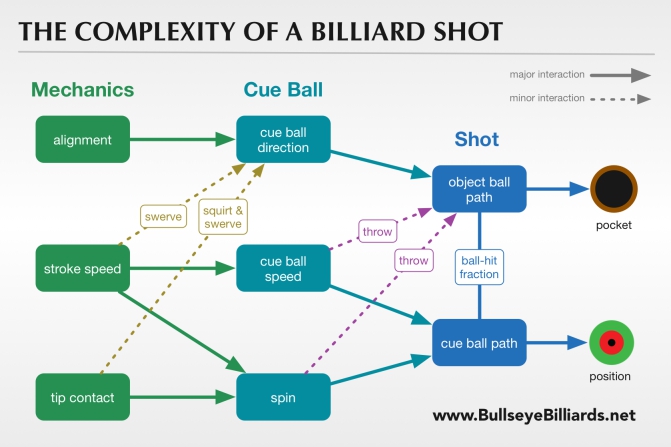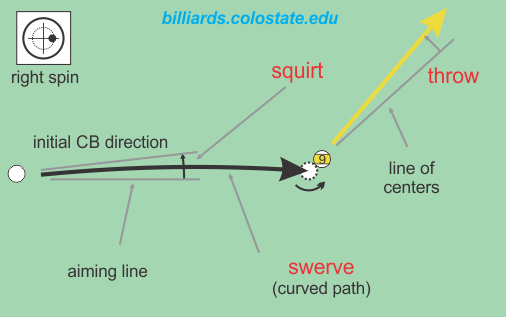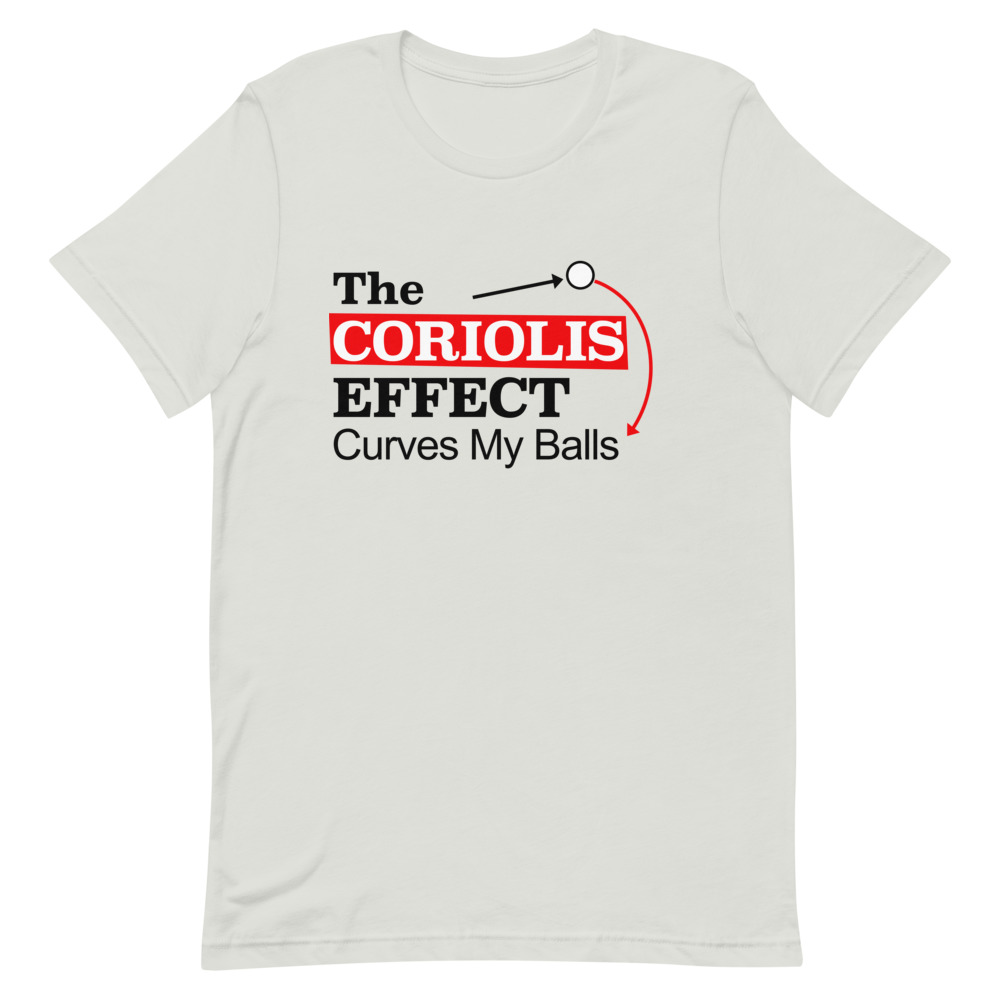What squirt (cue ball deflection), swerve, and throw effects do I need to be aware of?
A complete summary of all squirt (cue ball deflection), swerve, and throw effects and rules of thumb can be found below.
As background, here are some pertinent video demonstrations, the last two from the Video Encyclopedia of Pool Shots (VEPS):
The following diagram from Jeremiah Gage (courtesy of BullseyeBilliards) nicely illustrates the numerous interactions that occur in the execution of a shot, especially when english (sidespin) is used.

The numbered list below is a quick summary of important squirt (cue ball deflection), swerve, and throw effects, along with links to supporting resources. Let’s start with a short glossary of definitions and an illustration of some of the terminology used in the effects list. More definitions can be found in the online glossary, and additional info and examples can be found in the linked resources.
| BHE: back-hand english CB: cue ball CIT: cut-induced throw FHE: front-hand english gearing OE: the amount of outside english that results in no throw | IE: inside english OB: object ball OE: outside english SIT: spin-induced throw squerve: combination of squirt and swerve |

Here is a cool T-shirt including the illustration above along with the math/physics equations describing the effects:
And many more interesting pool physics shirts/caps/mugs are available at DrDaveBilliardTshirts.com:
Dr. Dave keeps this site commercial free, with no ads. If you appreciate the free resources, please consider making a one-time or monthly donation to show your support:
Squirt (cue ball deflection), Swerve, and Throw Effects
(everything you ever wanted to know about squirt, swerve, and throw)
- Squirt increases with the amount of sidespin.
- Squirt does not depend on shot speed (although, squerve does; see squirt speed effects for more info).
- Squirt increases with the amount of shaft endmass (e.g., a low-squirt cue has less endmass and results in less squirt).
- Squirt is slightly less with a heavier CB and slightly more with a lighter CB (see CB weight effects).
- Swerve increases with cue elevation and the amount of sidespin.
- Swerve occurs with practically all sidespin shots because the cue must be elevated to clear the rails.
- Swerve is delayed with faster shot speed.
- Swerve occurs only while the CB is sliding; once rolling begins, the CB heads in a straight line.
- Swerve occurs earlier with sticky cloth and later on slick cloth.
- Swerve occurs earlier with a follow shot than with a draw shot (see “Squirt – Part VIII: squerve effects” – BD, March, 2008).
- Swerve angle is larger with a draw shot than with a follow shot (see “Squirt – Part VIII: squerve effects” – BD, March, 2008).
- Swerve angle can be predicted and visualized using the Coriolis massé-shot aiming system.
- Squerve (net effect of squirt and swerve = net CB deflection) can be zero with certain speeds and cue elevations for a given shot distance, amount of sidespin, and cue.
- Squerve is less for follow vs. draw shots (see squirt tip-contact-height effects).
- Squirt or squerve can be canceled using back-hand english (BHE) and/or front-hand english (FHE) aim-and-pivot methods.
- For small cut angle shots (i.e., fuller hits), the amount of CIT does not vary with shot speed, but increases with cut angle (see throw speed effects).
- For larger cut angle shots (i.e., thinner hits), the amount of CIT is significantly larger for slower speed shots as compared to faster speed shots (see throw speed effects).
- The amount of CIT decreases some with larger cut angles, but not by much (especially for slower speed shots) (see “Throw – Part II: results” – BD, September, 2006).
- Maximum CIT occurs at close to a half-ball hit (30° cut angle) (see “Throw – Part II: results” – BD, September, 2006).
- In general, throw is larger at slower speeds, and for stun shots (see throw speed effects and throw draw/follow effects).
- Maximum throw, under typical conditions, is about 1 inch per foot of OB travel, or 1/2 a ball per diamond on a 9′ table, which is about 5°.
- Excessive throw (more than the amount expected) can occur if there is cling/skid/kick, especially at larger cut angles (see the bottom of TP A.14 and TP A.17.
- Both topspin and bottom spin reduce throw (by as much as 75% for cut angles up to about 30°), and they do so by the same amount (see throw draw/follow effects).
- Effective throw (combined effect of throw and OB swerve) can be slightly larger with follow vs. draw shots, especially at slower speeds (and with cling/skid/kick).
- The largest discrepancy between throw values for stun and follow/draw shots occurs close to a half-ball hit (30° cut angle), where throw is about 1/4 the stun value (see throw draw/follow effects).
- The difference between the throw of stun and follow/draw shots is not as great at larger cut angles (see throw draw/follow effects).
- More sidespin gives you more SIT only up to a point. Additional sidespin beyond that point actually reduces the amount of SIT (i.e., more sidespin doesn’t always give you more throw) (see throw speed effects and maximum throw).
- SIT is largest for a slow stun shot with about 50% of maximum sidespin (see throw speed effects and maximum throw). For how this changes with shot speed and cut angle, see TP B.25 – Percentage Sidespin Required for Maximum SIT at Any Cut Angle.
- The amount of throw can increase significantly as a small amount of sidespin is added, especially for a stun shot (see “Throw – Part IV: spin-induced throw” – BD, November, 2006).
- SIT is independent of speed (i.e., the throw is the same at all speeds) for small amounts of sidespin (see throw speed effects).
- “Gearing” OE results in absolutely no throw. The amount of sidespin required for “gearing” increases with cut angle. At a half-ball hit, the amount of sidespin required is about 50% (see gearing outside english).
- At very small cut angles, IE and OE create similar amounts of throw (although, in opposite directions) (see “Throw – Part VII: CIT/SIT combo” – BD, February, 2007).
- For large cut angles, a small amount of OE can result in more throw than shots with no sidespin (see “Throw – Part VII: CIT/SIT combo” – BD, February, 2007).
- For large cut angles, IE results in less throw than shots with no sidespin (see “Throw – Part VII: CIT/SIT combo” – BD, February, 2007).
- IE increases throw at small cut angles, but actually reduces the amount of throw at larger cut angles (see “Throw – Part VII: CIT/SIT combo” – BD, February, 2007).
- OE can cause throw in either direction depending on the amount of sidespin and the cut angle (see “Throw – Part VI: inside/outside english” – BD, January, 2007).
- Even for large cut angle shots (thin hits), excess OE (more than the “gearing” amount) can be applied to throw the OB in the SIT direction (see gearing outside english).
- The amount of throw with IE can be much more consistent than with OE if the amount of sidespin varies a little. In other words, the amount of throw varies more with tip placement for OE vs. IE. This might explain why some people prefer using IE on cut shots … because they can better anticipate and adjust for the amount of throw (see inside spin effects).
- The least amount of throw, and the most throw consistency, occurs with fast IE shots (see inside spin effects).
- With a small-gap combo with a gap size close to 3/8″ (9.5mm), the 2nd ball heads very straight (i.e., the throw effect cancels the cut effect) over a fairly wide range of 1st-ball angles, regardless of ball conditions (see small-gap combos).
Here are good demonstrations of the most important throw effects:
The System for Aiming With Sidespin (SAWS) covers a comprehensive system to aim accurately and consistently with sidespin over a wide range of shots.
A good summary of the basic things you need to know about throw in your game can be found at the bottom of the throw tutorial page. See also: answers to many common questions about throw.
For a more advanced approach for aiming with throw, see AIM – A system for practicing and learning how to adjust the target line of your shot to account for throw over a wide range of shots.
Here’s a good video by CueAndMe showing a carefully-executed experiment clearly showing the effects of cut angle and spin on throw. Results of similar experiments can be found in “Throw – Part II: results” (BD, September, 2006) and in the plot from Bob Jewett’s June, 1995 BD article.
Graphs/plots showing in detail how throw varies with everything can be found in TP A.28 – Throw plots for all types of shots and TP B.3 – Throw calibration and contour plots for various cut angles, speeds, English, and roll.
A good technical analysis and presentation of squirt effects can be found in Ron Shepard’s “Everything you Always Wanted to Know About Cue Ball Squirt, but Were Afraid to Ask.” Here’s a good summary of squirt effects from that document.
Dr. Dave keeps this site commercial free, with no ads. If you appreciate the free resources, please consider making a one-time or monthly donation to show your support:





